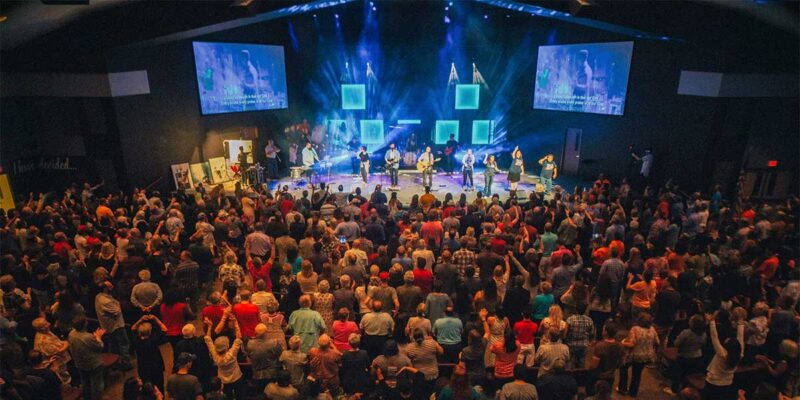Tech Updates in Traditional HOW Spaces: The Challenges

The more things change, the more they stay the same.
As time and technology have progressed, styles and trends have shifted in the house-of-worship world just as they have in the rest of it. In the HOW market, these shifts are especially difficult to reconcile — HOWs often have limited resources as well as significant ties to traditional elements. A prime example of this can be found in architectural designs. In a secular concert space, when a facility no longer meets the needs of the technological demands or style, things can be renovated or replaced.
The Challenges
These days, many concerts are held in black box spaces or arenas rather than traditional theater venues. These spaces usually have an infrastructure to support the standard for modern AVL systems. Often, the technology is already there and up to date.
As mentioned above, it’s different in a HOW environment. Aside from availability of resources, key stakeholders often have deep connections to worship spaces and would rather find solutions that work within those them than abandon them altogether. This created a unique challenge as the level of technology many attendees seek doesn’t naturally play as well in the — however beautiful — traditional spaces.
Lighting
A trademark of traditional HOW spaces are high vaulted ceilings. These can provide a unique challenge when it comes to stage lighting because the fixtures have to live so far from the subject. Using LED movers (such as the Ayrton Ghibli, for example), HOWs are able to deploy fixtures out of sight lines without major concerns of adequate coverage or lifespan. Using motorized fixtures also gives the technical staff a pivot foot moving forward if the primary subject area were to change for a specific service or performance.
Standard LED lekos can also serve as a reliable option, especially in deployments in which moving fixtures don’t fit within budget constraints. The functional loss here is that once the fixtures are framed in place, they’ll be stationary unless someone gets to them. This is often a time-consuming venture involving a lift or ladder (depending on the space itself).
Sound
Another pain point in most traditional spaces comes into play when considering a properly deployed PA system. These spaces were typically designed with little to no technological sound reproduction in mind. As worship music styles continue to evolve and modernize, it has become more significant for these spaces to deploy systems that can match that same level of energy.
The rub immediately comes from the optics of the box itself or from the size of the array that may suit the room best. Many PA manufacturers, like d&b audiotechnik, have a custom solutions division that can help construct custom rigging brackets, for example, to help create subtle hangs that still have the necessary power to cover the room evenly.
With traditional spaces designed to naturally amplify the voice, managing acoustics can be a difficult task. Ideally, you want to provide enough absorption to give the audio technician some control of the space, while also preserving the acoustic qualities of the room itself. When people enter a cathedral, for instance, they expect to perceive sound in a certain way — it’s a little disorienting if that’s not the case. One solution that could help to accomplish this would be through wall treatments and leaving the ceiling relatively untreated, this allows some of the sound energy to reflect off the vaulted ceiling while still limiting the amount of “slapback” that is actually reflected into the audience.
Video
When it comes to video, the problem in traditional spaces is usually sight lines and unsightly projectors hanging down from the ceiling. There are a few different solutions to help solve this. The more cost-effective option is a laser projector with a long-throw lens. This allows the projector to be deployed in the rear of the auditorium, no longer causing any distractions. The problem with this solution is that many traditional spaces have lots of natural light that the projector would have to cut through. Lamp-based projectors struggled with this task even more due to more limited lumen counts; the advancement of laser projector technology has allowed for a much easier entry point at a higher lumen count. This allows projectors to cut through natural light and accurately throw across extended distances.
The alternative solution is LED displays. While LED is more expensive and comes with a more expansive list of variables (for example: structural concerns and power availability), they do not have to battle against cutting through natural light as the light source is internal. A properly deployed LED wall can also minimize unsightly gear; they can be deployed from the ceiling, floor or wall mounted. This allows the screens to illuminate the space, when in use, while becoming part of the background when not.
It is often theorized that traditional HOWs don’t upgrade their AVL because they do not consider technology a priority. While I’m sure that is sometimes the case, I believe that it can usually be chalked up to a lack of understanding regarding these systems and how they can be deployed. The types of make and models that “do their job” that are also subtle enough to serve a traditional space come at a higher cost but are well worth the investment when you consider the overall goal: to preserve the space for years to come.





